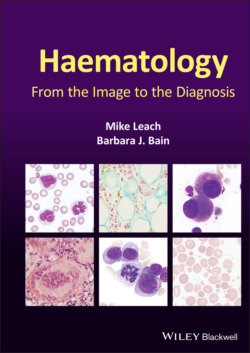Читать книгу Haematology - Barbara J. Bain, Irene Roberts - Страница 17
Оглавление8 Gelatinous transformation of the bone marrow
A 60‐year‐old man with chronic debility due to neurosarcoidosis was referred for investigation of a normocytic anaemia with Hb 100 g/l and normal leucocyte and platelet counts. The blood film was not informative. He underwent bone marrow aspiration. The aspirate was hypocellular but did not show any definitive diagnostic features. The bone marrow trephine biopsy specimen was abnormal, showing hypocellularity with reduction of haemopoietic activity around the marrow fat spaces (top images, H&E) (all images ×50 objective). The hypocellular areas show preserved architecture and an amorphous myxoid (mucoid) interstitium. Subsequent staining with Alcian blue (bottom left and centre) and periodic acid–Schiff (bottom right) confirmed the diagnosis of gelatinous transformation, also known as myxoid degeneration.
Typically, this condition involves the marrow diffusely (above left, H&E and right, Alcian blue ×50), resulting in peripheral blood cytopenias with neutropenia and anaemia being most frequent. Gelatinous transformation of the bone marrow is an important condition to recognise and should not be mistaken for marrow aplasia or marrow necrosis. It is typically seen as part of the catabolic response to chronic debilitating disease (malignant or non‐malignant) and/or malnutrition. The condition will regress on treating the underlying cause.
MCQ
1 Myxoid degeneration (gelatinous transformation) can be a feature of:Acquired immune deficiency syndromeAnorexia nervosaExtreme exerciseMetastatic carcinomaMorbid obesityFor answers and discussion, see page 206.
